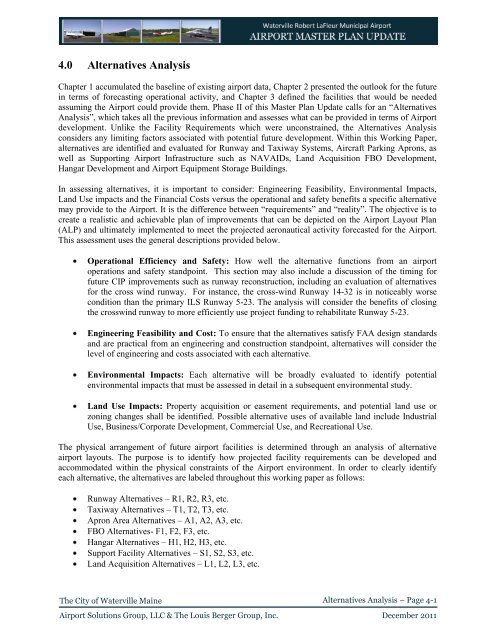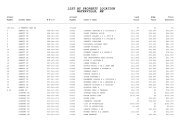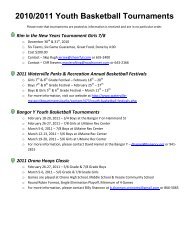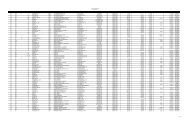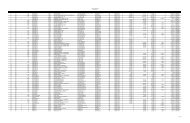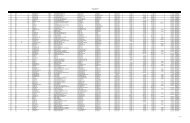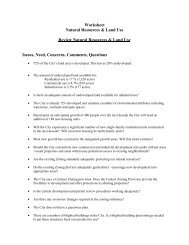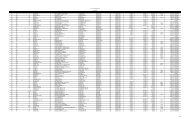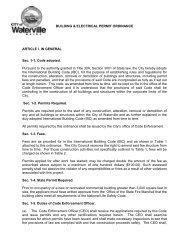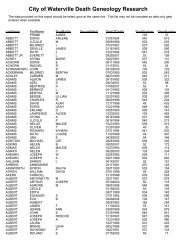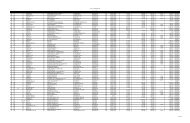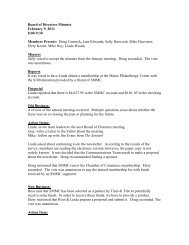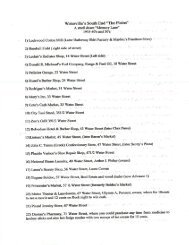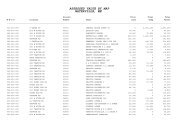Airport Master Plan 2012 - City of Waterville
Airport Master Plan 2012 - City of Waterville
Airport Master Plan 2012 - City of Waterville
Create successful ePaper yourself
Turn your PDF publications into a flip-book with our unique Google optimized e-Paper software.
4.0 Alternatives Analysis<br />
Chapter 1 accumulated the baseline <strong>of</strong> existing airport data, Chapter 2 presented the outlook for the future<br />
in terms <strong>of</strong> forecasting operational activity, and Chapter 3 defined the facilities that would be needed<br />
assuming the <strong>Airport</strong> could provide them. Phase II <strong>of</strong> this <strong>Master</strong> <strong>Plan</strong> Update calls for an “Alternatives<br />
Analysis”, which takes all the previous information and assesses what can be provided in terms <strong>of</strong> <strong>Airport</strong><br />
development. Unlike the Facility Requirements which were unconstrained, the Alternatives Analysis<br />
considers any limiting factors associated with potential future development. Within this Working Paper,<br />
alternatives are identified and evaluated for Runway and Taxiway Systems, Aircraft Parking Aprons, as<br />
well as Supporting <strong>Airport</strong> Infrastructure such as NAVAIDs, Land Acquisition FBO Development,<br />
Hangar Development and <strong>Airport</strong> Equipment Storage Buildings.<br />
In assessing alternatives, it is important to consider: Engineering Feasibility, Environmental Impacts,<br />
Land Use impacts and the Financial Costs versus the operational and safety benefits a specific alternative<br />
may provide to the <strong>Airport</strong>. It is the difference between “requirements” and “reality”. The objective is to<br />
create a realistic and achievable plan <strong>of</strong> improvements that can be depicted on the <strong>Airport</strong> Layout <strong>Plan</strong><br />
(ALP) and ultimately implemented to meet the projected aeronautical activity forecasted for the <strong>Airport</strong>.<br />
This assessment uses the general descriptions provided below.<br />
Operational Efficiency and Safety: How well the alternative functions from an airport<br />
operations and safety standpoint. This section may also include a discussion <strong>of</strong> the timing for<br />
future CIP improvements such as runway reconstruction, including an evaluation <strong>of</strong> alternatives<br />
for the cross wind runway. For instance, the cross-wind Runway 14-32 is in noticeably worse<br />
condition than the primary ILS Runway 5-23. The analysis will consider the benefits <strong>of</strong> closing<br />
the crosswind runway to more efficiently use project funding to rehabilitate Runway 5-23.<br />
Engineering Feasibility and Cost: To ensure that the alternatives satisfy FAA design standards<br />
and are practical from an engineering and construction standpoint, alternatives will consider the<br />
level <strong>of</strong> engineering and costs associated with each alternative.<br />
Environmental Impacts: Each alternative will be broadly evaluated to identify potential<br />
environmental impacts that must be assessed in detail in a subsequent environmental study.<br />
Land Use Impacts: Property acquisition or easement requirements, and potential land use or<br />
zoning changes shall be identified. Possible alternative uses <strong>of</strong> available land include Industrial<br />
Use, Business/Corporate Development, Commercial Use, and Recreational Use.<br />
The physical arrangement <strong>of</strong> future airport facilities is determined through an analysis <strong>of</strong> alternative<br />
airport layouts. The purpose is to identify how projected facility requirements can be developed and<br />
accommodated within the physical constraints <strong>of</strong> the <strong>Airport</strong> environment. In order to clearly identify<br />
each alternative, the alternatives are labeled throughout this working paper as follows:<br />
Runway Alternatives – R1, R2, R3, etc.<br />
Taxiway Alternatives – T1, T2, T3, etc.<br />
Apron Area Alternatives – A1, A2, A3, etc.<br />
FBO Alternatives- F1, F2, F3, etc.<br />
Hangar Alternatives – H1, H2, H3, etc.<br />
Support Facility Alternatives – S1, S2, S3, etc.<br />
Land Acquisition Alternatives – L1, L2, L3, etc.<br />
The <strong>City</strong> <strong>of</strong> <strong>Waterville</strong> Maine<br />
Alternatives Analysis – Page 4-1<br />
<strong>Airport</strong> Solutions Group, LLC & The Louis Berger Group, Inc. December 2011


